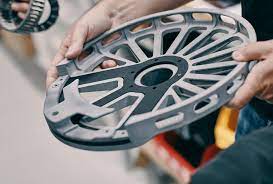Nylon PA12 and Nylon PA11: What is the Difference?
- cvanhoogevest
- May 21, 2023
- 2 min read
The rapid advancements in 3D printing technology and materials over the past decade have made it increasingly popular for product development and manufacturing end-use products. One of the most popular materials for industrial 3D printing is nylon because of it’s excellent material properties and versatility. However, there are a variety of types of nylon used for 3D printing, the two most common being Nylon PA11 and Nylon PA12. This article explains the key differences between the two when 3D printed with HP Multi Jet Fusion 3D printing technology.

About Nylon
Nylons are polyamides made from reacting carbon-based chemicals in a high-temperature, high-pressure environment. This chemical reaction, known as condensation polymerization, forms a polymer made of long chains of molecules which give nylon it's strength, flexibility and long-lasting durability.
There are different varieties of nylon, each with unique properties. Their chemical compositions are identified with specific naming conventions. With Nylon PA11 and PA12, the PA stands for Polyamide, and the numbers identify the ratio of carbon atoms in their chemical components.
Chemically, Nylon 12 and Nylon 11 are very similar, but the difference in carbon atoms results in two distinct plastics, each with unique benefits.
Nylon PA11 and Nylon PA12: How do they compare?
Nylon PA12 is a synthetic polyamide created from petroleum materials. Compared to Nylon 11, Nylon 12 has greater resistance to temperature extremes and can stay strong in below-freezing temperatures. Nylon 12 is also stiffer than Nylon 11, is resistant to cracking and is extremely long-lasting.
Nylon PA11 is a bioplastic polyamide created from vegetable and castor oil, which means that Nylon 11 has a lower environmental impact than Nylon 12. Overall Nylon 11 has greater elasticity and thermal resistance than Nylon 12. Both are stable in UV light and weather.
Nylon PA12 properties

Most commonly used nylon for 3D printing applications.
Chemically resistant to oils, fuels, grease, solvents, hydraulic fluids, salts, and water.
Excellent resistance to heat.
High wear resistance.
Commonly used for a variety of uses, including fully functioning end-use parts and as an alternative to injection-molded plastics.
Nylon 11 properties

Chemically resistant to hydrocarbons, ketones, aldehydes, fuels, alcohols, oils, fats, mineral bases, salts and detergents.
Low water absorption.
Impact resistant.
Good resistance to heat.
Commonly used for functional parts that require high strength or impact resistance. Uses include mechanically loaded functional prototypes, automotive interiors, and moving assemblies (such as hinges).
Conclusion
The excellent material properties of Nylon have made it one of the most commonly used plastics for manufacturing and 3D printing. Understanding the differences between Nylon PA12 and Nylon PA11 can ensure you get the best results for your end-use application.
Ready for your next project?
To learn more about the material properties and end-use applications of nylon and other engineering-grade 3D printing plastics which are 3D printed with HP Multi Jet Fusion technology, check out Tempus 3D’s materials comparison page. If you are ready to create your next project, visit our online quote and ordering page for pricing and ordering details. .
Tempus 3D is a Canadian 3D printing service bureau which specializes in manufacturing affordable, high-quality engineering-grade plastics using industry-leading HP Multi Jet Fusion 3D printing technology.
Sources: www.hp.com/us-en/printers/3d-printers/products/multi-jet-technology.html, www.weerg.com/guides/nylon-pa-11-vs-pa-12. Images courtesy of HP.




